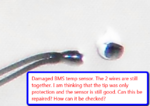How can the battery on iZip Metro be taken out?
Actually I am not sure of the model of the bike so pictures are enclosed. If you can identify the model from the pictures please do so.
Tried to access the battery from below the frame tube as shown in the pictures but not possible from what I see, unless everything is disconnected. I thought there surely must be an easier way to access it.
The battery has about zero voltage measured at the charging port. The bike must have sat for a long time (at least 6 months but probably more than a year). The charger won't turn on and I suspect it is due to not enough voltage at the battery.
Is the charger dependent on a minimum voltage at the battery to turn on?
Is there anyway to try to get the battery charged without taking it out? I have another used weak battery 37V 14A. I thought of charging this one and then connecting it to the charge port of the iZip bike to see if the voltage of the iZip battery gets high enough for the charger to start charging. Thank you.
Actually I am not sure of the model of the bike so pictures are enclosed. If you can identify the model from the pictures please do so.
Tried to access the battery from below the frame tube as shown in the pictures but not possible from what I see, unless everything is disconnected. I thought there surely must be an easier way to access it.
The battery has about zero voltage measured at the charging port. The bike must have sat for a long time (at least 6 months but probably more than a year). The charger won't turn on and I suspect it is due to not enough voltage at the battery.
Is the charger dependent on a minimum voltage at the battery to turn on?
Is there anyway to try to get the battery charged without taking it out? I have another used weak battery 37V 14A. I thought of charging this one and then connecting it to the charge port of the iZip bike to see if the voltage of the iZip battery gets high enough for the charger to start charging. Thank you.














